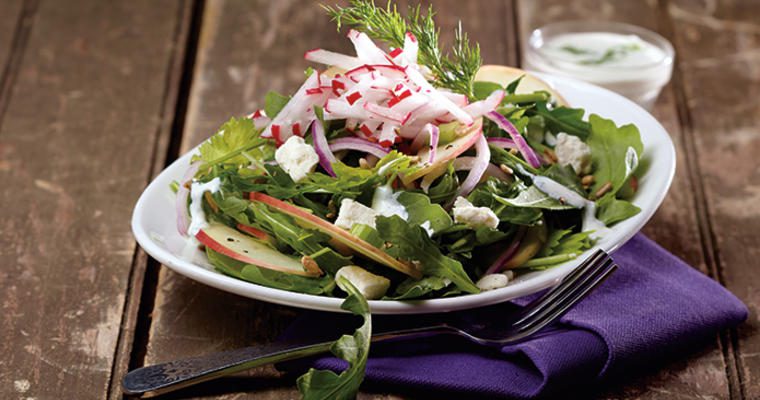The emergence of veg-centric cooking has a lot going for it—simple vegetables, creatively prepared, with a bold, fresh center-of-the-plate appeal. The challenge confronting many chefs and kitchen managers is menu implementation.
Here are 5 ideas to Get You Started on the Veg-Centric Opportunity
1. Promote the Economy and Flavor of Root-to-Stem Cooking
Diners are interested in sustainability, and veg-centric cooking delivers. Using every possible bit of the plant reduces kitchen waste. Letting customers know about how it helps the planet and adds sophisticated layers of flavor will set your operation apart.
“Take your vegetable peelings, season them, and roast them to build a vegetable broth,” says Gerry Ludwig, CEC, Gordon Food Service Corporate Consulting Chef. “Using everything from potato peels to artichoke leaves to ginger peelings takes what used to be waste and turns it into flavor and profit.”
Ludwig’s recent external research revealed root-to-stem approaches that were paying off in a New York City restaurant. At Chalk Point Restaurant, Chef Joe Isidori takes food waste once turned into compost and has moved it to his center of the plate cuisine.
“By reusing what used to be waste, he recouped about 1 percent to his bottom line,” Ludwig notes.
Andrew Carmellini at NYC’s Little Park Restaurant gets 100 percent yield out of his broccoli by using parts and pieces as colorful bombs—as garnishes, the leaves and trimmings become a green sauce, and the stalks are pickled and then shaved to add texture and flavor.
2. Think Small
There’s no need to transform the menu, or even add a veg-centric section. It’s essential to recognize your brand, and introduce veg-centric offerings where they fit. If you run a steakhouse, your customers show up to eat great steaks. In this case, introduce one dish with veg-centric appeal and see where it leads.
“Give customers a taste of your creativity,” says Rob Granberg, Consulting Chef for Gordon Food Service Central States Division. “If you offer a chef’s special, a side dish, a shareable portion, or just a complimentary sample, you’ll get some feedback that may generate a permanent menu offering.”
3. Start With Exciting Sharables
Grilled asparagus with burrata, red peppers, and a basil pesto sauce can give everyone at the table a taste of veg-centric cooking. Make the experience even more exciting by considering the presentation.
“Put the food on a wooden plank and turn heads as you carry it through the dining room,” Granberg says. “When people ask “What is it?” you drive energy and demand—the next thing you know, you’re adding two or three more dishes or even a whole menu category.”
4. Take a Seasonal Approach
Diners are accustomed to locally sourced, seasonal foods. This is reinforced by the popularity of farmers markets in almost every community. This mindset fits right in with veg-centric cooking. The fresh, natural profile of vegetables and fruits is familiar and comfortable. It’s your ability to deliver unique cooking styles and flavor combinations that will get restaurant guests talking.
“You can have a new vegetable dish every month or every season,” says John Horvath, a Gordon Food Service Dairy/Produce Product Specialist. “I just want to encourage chefs to use their authority to create exciting dishes. Experiment with roasting vegetables in your homemade beer, or charring and grilling them to bring out the caramelized sweetness.”
5. Promote Creativity and Customization
Think a carrot is just a carrot? With a little creativity you get an experience that has diners talking about the flavor first and the vegetable second. And every dish can be customized to match personal flavor preferences.
“A carrot is familiar to everyone,” says Gordon Food Service Grocery/Bakery Product Specialist Dennis Rynicke. “But adding a different flavor profile or using an aggressive cooking style creates something unique for each guest that can’t replicated at home.”
Aggressive cooking styles—braising, roasting, searing, deep-frying, and even demonstration cooking at an outdoor patio grill or wok—make already delicious vegetables even more memorable. Blending in a small portion of protein, a sprinkle of zesty seasoning, or topping with a rich aioli or sauce lends flavor and customization without a lot of cost.
The secret to veg-centric success rests mostly with your imagination. Ludwig points out that the goal is to target the omnivorous eaters who already like vegetables, but would like them even more if you made them taste great.




























